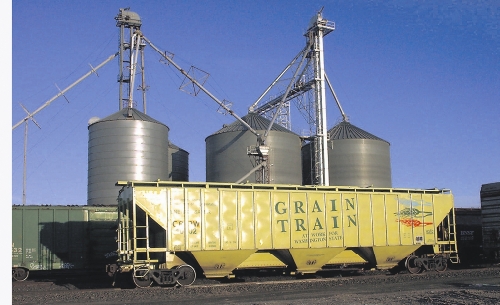the film
forum
library
tutorial
contact
|

|
New Analysis Shows Significant Rail Capacity in Southeast
Washington State to Replace Barging on the Lower Snake River
by Solutionary Rail
Yahoo! News, November 1, 2022
|
Existing rail line from Lewiston to Ayer to Tri-Cities to Portland could accommodate several unit trains per day
 SEATTLE, Wash., -- A new analysis by Solutionary Rail indicates substantial rail capacity is available in southeast Washington State to quickly replace barging on the Lower Snake River.
SEATTLE, Wash., -- A new analysis by Solutionary Rail indicates substantial rail capacity is available in southeast Washington State to quickly replace barging on the Lower Snake River.
Solutionary Rail (SR) assessed the historic, current, and potential future of rail service for shipping grain that is currently transported by barge on the lower Snake River (LSR). The report includes a review of multiple barge loading and elevator facilities along the lower Snake and their potential conversion to rail transportation.
Based on a 12-year average, LSR barges move 2.4 million tons of grain annually. To replace current barge service with rail would require the equivalent of five (5) additional unit trains per week. The SR report emphasizes the importance of investing in capacity and connectivity of the four short line railroads that serve the area. Currently, the majority of barged grain is loaded on the top two sections of the system, i.e. above Little Goose and Lower Granite Dams. Any transition away from barges will initially require significant rail service along the river.
Solutionary Rail evaluated the track capacity of Great Northwest Railroad (GRNW) between Lewiston and the Union Pacific rail yard in Ayer. GRNW either currently serves or could easily serve three of the five port facilities on the top two sections of the river, including LC Terminal, Port of Wilma, and Central Ferry Terminal, as well as potentially Lyons Ferry on the south side of the river immediately east of Ayer.
According to SR's analysis, the GRNW line could accommodate three (3) or more 110-car unit trains per day. It currently averages one (1) train per day. If the 1.4-mile siding at Riparia were used for passing trains, the GRNW line could accommodate as many as six (6) unit trains per day, more than enough capacity to handle grain shipments at even the busiest months of the year.
Solutionary Rail's proposal outlines a longer term strategy for reducing expensive truck miles with a series of proposed system improvements. These improvements are designed to enhance service, capacity, and connectivity of the four short line railroads that serve the area, not just GRNW. The proposed repair and restoration of track and railbed, most of which is already owned by Washington state, would provide options that increase competition and resilience.
"Solutionary Rail urges Governor Inslee to leverage this historic opportunity provided by the Infrastructure and Investment Jobs Act and the Inflation Reduction Act, along with the need to prevent the extinction of Snake River fish, to invest in a rail system that will better serve farmers, co-ops, and communities in SE Washington for generations to come," said Bill Moyer, Solutionary Rail Campaign Lead.
Solutionary Rail's complete analysis of wheat transport on the Lower Snake River is available at Solutionary Rail.org/LSRbarge2rail.
For more information, contact Bill Moyer of Solutionary Rail at 206-356-9980.
Related Pages:
Can Trains Save Salmon? by Bill Moyer, Spokesman-Review, 10/29/22
Solutionary Rail, Moscow
New Analysis Shows Significant Rail Capacity in Southeast Washington State to Replace Barging on the Lower Snake River
Yahoo! News, November 1, 2022
See what you can learn
learn more on topics covered in the film
see the video
read the script
learn the songs
discussion forum


 SEATTLE, Wash., -- A new analysis by Solutionary Rail indicates substantial rail capacity is available in southeast Washington State to quickly replace barging on the Lower Snake River.
SEATTLE, Wash., -- A new analysis by Solutionary Rail indicates substantial rail capacity is available in southeast Washington State to quickly replace barging on the Lower Snake River.
